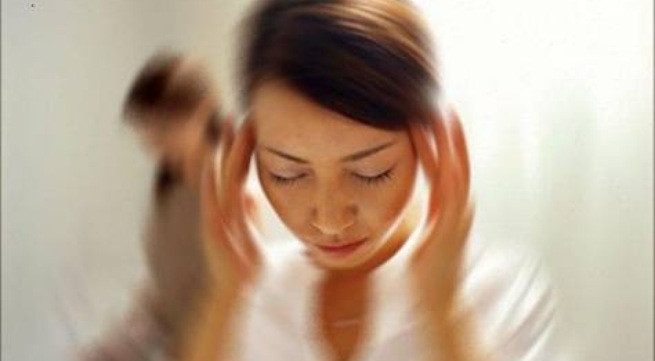Remedies for dizziness and tinnitus
Dizziness and tinnitus are included in the category of vertigo in traditional Chinese medicine. The cause is due to deficiency of kidney yin and liver blood (deficiency syndrome) or due to rise of liver yang, excess liver fire, phlegm and dampness (excess syndrome). Modern medicine considers the cause to be vestibular disorders, high blood pressure, arteriosclerosis, anemia... Here are some remedies for each type.
 |
| People with Meniere's syndrome often have dizziness, tinnitus, nausea or vomiting... |
Can phong body
Caused by liver yang rising, liver fire flourishing, and liver and kidney yin deficiency. Often seen in people with high blood pressure, arteriosclerosis, sympathetic disorders, etc. The patient has symptoms of dizziness, tinnitus, dry mouth, bitterness, vomiting, restlessness, irritability, red tongue, thin and rapid pulse. The treatment is to calm the liver and stop the wind, calm yang or nourish kidney yin, nourish liver blood and calm yang. Use one of the following prescriptions:
Recipe 1: Gastrodia elata and Uncaria rhynchophylla drink: 12g Gastrodia elata, 16g Uncaria rhynchophylla, 12g Poria cocos, 16g Mulberry bark, 12g Euryale ferox, 12g Scutellaria baicalensis, 8g Gardenia fruit, 20g Cassia tora. Boil and drink 1 dose per day.
Lesson 2: Long dom ta can thang: used for people with high blood pressure causing dizziness, restlessness, insomnia, red urine, constipation, yellow tongue coating, dark and rapid pulse (due to liver fire): 12g long dom thao, 12g scutellaria baicalensis, 12g son chi, 16g bupleurum, 8g angelica, 12g woodpile, 16g xa tien, 8g trach ta, 12g dia long, 16g mau le song. Boil and drink 1 dose per day.
Phlegm and dampness
The patient has symptoms of obesity, dizziness, nausea, palpitations, nightmares, poor appetite, frequent morning phlegm, pale mouth, flabby tongue, sticky coating, and a fast pulse. The treatment is to eliminate dampness and phlegm. Use the modified Erchen Tang prescription: 8g tangerine peel, 8g processed pinellia, 8g poria, 4g licorice. Boil and drink 1 dose per day.
If the mouth is bitter, the tongue is dry, the urine is yellow, there is restlessness and constipation, use 8g of bamboo resin, 12g of Chinese clematis root, 8g of earthworm, 8g of gypsum root bark, and 12g of white peony.
If the tongue coating is white and sticky, loose stools, and no thirst, add 16g of codonopsis, 12g of atractylodes, and 8g of alisma.
Blood deficiency
Often seen in people with anemia and arteriosclerosis. Patients have symptoms of pale or yellow complexion, dizziness, anxiety, little sleep, fatigue, forgetfulness, poor appetite, irregular menstruation, little menstrual flow, pale complexion, pale tongue, little coating, thin and weak pulse. Use the following prescription:
Recipe 1: 16g rehmannia root, 12g ligusticum wallichii root, 12g wolfberry root, 16g polygonum multiflorum root, 16g tang ki sinh root, 12g achyranthes root, 12g longan root, 12g eclipta prostrata, 12g Chinese yam. Boil and drink 1 dose per day.
Recipe 2: Modified Bat Tran thang: 12g of cooked rehmannia root, 8g of ligusticum wallichii root, 8g of ligusticum root, 12g of white peony root, 16g of codonopsis root, 12g of white atractylodes root, 8g of poria root, 4g of licorice root, 12g of earthworm root, 16g of raw peony root, 20g of cassia seed, 16g of mulberry bark. Boil and drink 1 dose per day.
Lesson 3: Modified version of Tu Vuc thang: 12g of rehmannia root, 8g of chuan khung root, 12g of angelica root, 12g of white peony root, 16g of tang ki sinh root, 12g of wolfberry, 12g of longan root, 16g of polygonum multiflorum root, 8g of turtle glue, 2g of achyranthes root. Boil and drink 1 dose per day.
To increase the effectiveness of the treatment, daily massage the following acupoints: Neiguan, Shenmen, Fengchi, Dinghen, Sanyinjiao, and Hegu. Each acupoint for 1-2 minutes. 1-2 times a day.
If due to liver wind, add Taichong point.
If due to phlegm and dampness, add Fenglong and Zusanli points.
If due to blood deficiency, add spleen du, ge du, and gao hoang points.
Location of the acupuncture point
Internal organs: 2 inches above the wrist crease, between the tendons of the large and small palmar muscles.
Shenmen: On the ulnar side, located above the carpal crease, in the depression close to the lateral border of the anterior radial tendon and the lateral corner of the superior border of the ulna.
Phong Trì: At the depression of the medial border of the sternocleidomastoid muscle and the lateral border of the trapezius muscle attached to the base of the skull.
Asthma diagnosis: From the 7th cervical vertebra, measure 1 inch to the side.
Sanyinjiao: Close to the posterior-medial border of the tibia, measuring up 3 inches from the top of the inner ankle.
Hegu: Close the index finger and thumb together, the point is at the highest point of the index finger and thumb muscle.
Thai xung: After the gap between toes 1 and 2, measure up 1.5 inches, the point is in the depression created by the ends of the bones of toes 1 and 2.
Phong long: The top of the outer ankle is 8 inches.
Zusanli: Place the palm of your hand between the knees, the tip of the middle finger touches the shin bone (tibia), then slightly move outward to this point.
Spleen: Below the 11th dorsal spine, measure 1.5 inches horizontally.
How to travel: Below the 7th thoracic vertebra, measure 1.5 inches horizontally.
High back: Below the 4th spine, 3 inches wide.
According to Health and Life






